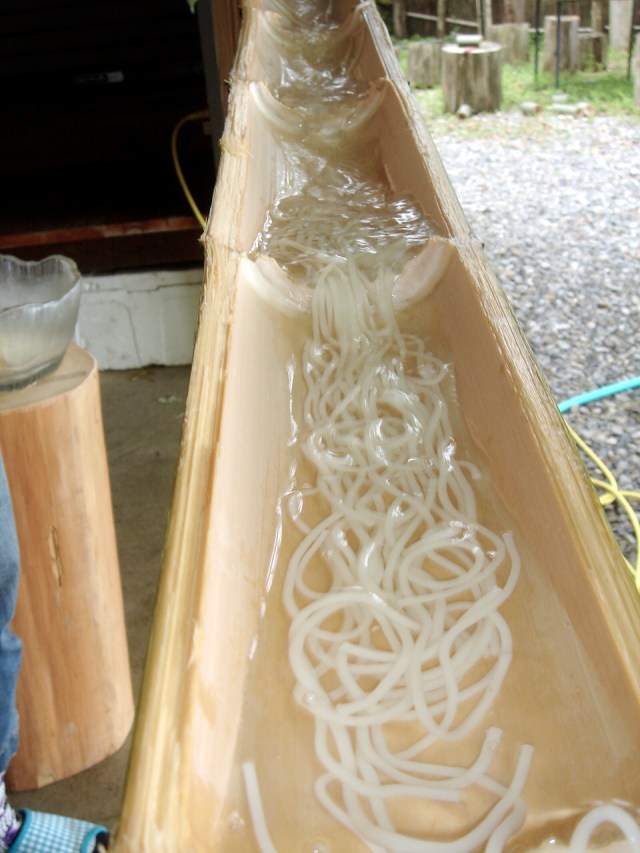Nagashi Sōmen: catch these floating noodles before they flow by!
4 min read
There is another type of noodles that has been enjoyed by the Japanese since time immemorial besides udon, ramen and soba – the sōmen.
And eating a dish of nagashi sōmen requires a nimble hand with chopsticks.
Otherwise your meal could flow right past you.
Yes, really.
Are you confident in your chopstick skills?
If you are, go ahead and prove it by trying eating flowing “ sōmen”(cold noodles) or “Nagashi-somen” in Japanese.
It is a fun Japanese way of eating in which the noodles are sered not in a traditonal bowl or a classic plate, but by racing through a bamboo pipe filled with cold water.
And so get those chopsticks ready to catch as many noodles as you can as they flow by!

So, what is sōmen?
They are white wheat noodles, which Japanese cooks serve cold or even over ice during the summer.
Typically, they’re boiled and cooled, then eaten with tsuyu, a sauce made from dashi soup stock and flavorful soy sauce, while its toppings could include also cucumber and sliced mushrooms.
Historically, the Japanese have eaten sōmen since the eighth century, and, according to historical records, it was believed that the Chinese brought these noodles to Japan during the Nara Period (710-794).
The first sōmen was called somochi, where rice flour was used to make the noodles instead of wheat. The noodles were made by twisting the dough like a rope (la mian), a technique used by the Chinese to warm the dough thereby allowing glutens to align.
Between 794-1185 also known as the Nara and Heian periods, the popularity of somen reached the Imperial Court, when it was served on special occasions.
Wheat began to replace rice flour as the sole ingredient in making somen during the Kamakura Period, from 1185 to 1333, and there are accounts of very thin wheat noodles being served regularly as a light meal (known as tenshin) at Buddhist temples during the Muromachi Period (1392-1573).
Sōmen noodles gradually spread to the general populace, mainly in areas where wheat was grown, such as western and southern Japan. By the 18th century, during the middle of the Edo Period (1603-1868), sōmen reached Edo, now present-day Tokyo, though it was the region around present-day Hyogo Prefecture that was especially renowned for producing top-quality thin noodles.
Noodle-makers were judged by how thin, smooth and white their sōmen was.
To achieve a fine, silky smoothness it is common practice — since the early days — to coat the strands with a little oil, and most commercially produced sōmen is still made this way, although there are oil-free versions, too.
Sōmen used to be served in long strands rather than the short, cut version that is eaten today.
However, eating long noodles was awkward, so most people cut them up before eating them.
People didn’t start floating their noodles down artificial rivers, though, until modern times.
In the southern town of Takachiho, in 1959, the House of Chiho restaurant dreamed up nagashi (literally flowing) sōmen in order to capitalize on the pure, local spring water.
In a tradition that continues still today, staff fill long chutes of halved bamboo trunks with cold running water.
Once they yell “Ikuyo!”, something like “It’s coming!”, they add strings of cooked noodles for diners downstream to snatch out of the current.
At most establishments, a basket at the end of the waterworks catches slippery noodles, and the staff retrieves them for customers.
But at the well-known Hirobun restaurant in Kyoto, what you catch is what you get, until red-dyed somen floats through and signals the end of the meal.

This is a summer tradition, often seen at festivals and in restaurants, but families can also rig up their own backyard bamboo pipes.
As an alternative, home cooks and restaurateurs can buy machines that spin noodles around circular basins or send them down miniature water slides that look like toys.
Still, the traditional style has a special appeal.
In 2016, the citizens of Gose, in Nara prefecture, set the Guinness World Record for “longest distance to flow noodles down a line of bamboo gutters.”
Basically, they built a working nagashi somen chute that was 3,317 meters (10,871 feet) long.
Other record-breakers, meanwhile, have used high-pressure washing machines to power noodles to speeds that created actual waves.
Either way, cut bundles of dried sōmen noodles are the form that’s most common today.
Dried sōmen keeps very well, and it actually used to be aged for two to three years (sometimes even longer) before it was shipped often as a gift among the wealthy, to improve the flavor and maintain quality.
Boxes of sōmen are still popular chugen (mid-summer gifts).




Images from web – Google Research





